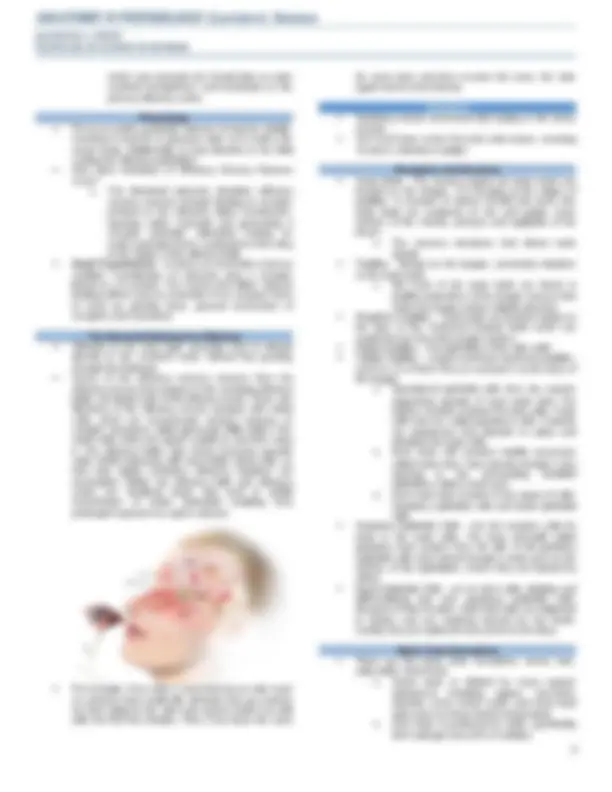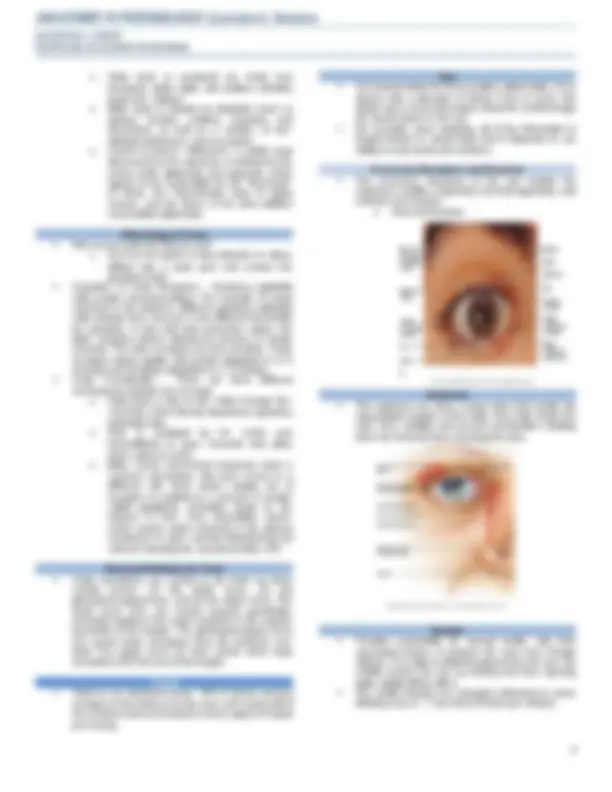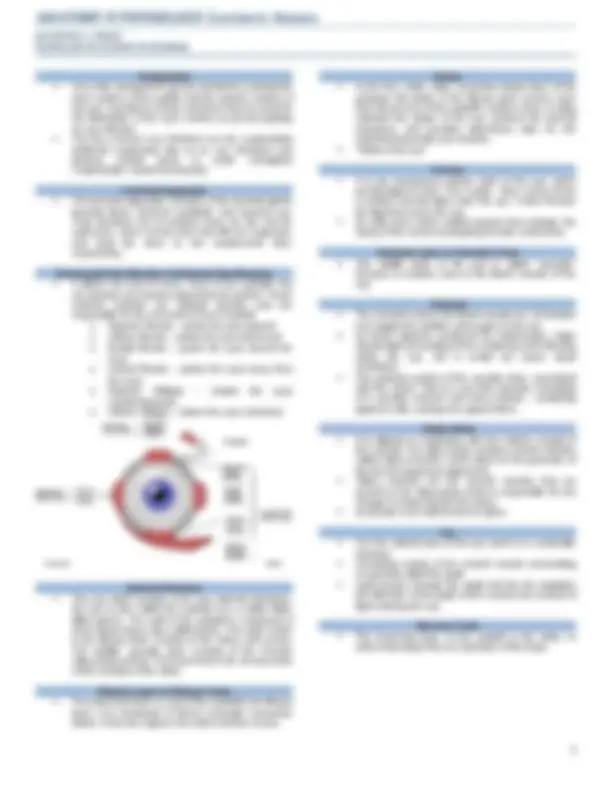








Study with the several resources on Docsity

Earn points by helping other students or get them with a premium plan


Prepare for your exams
Study with the several resources on Docsity

Earn points to download
Earn points by helping other students or get them with a premium plan
Community
Ask the community for help and clear up your study doubts
Discover the best universities in your country according to Docsity users
Free resources
Download our free guides on studying techniques, anxiety management strategies, and thesis advice from Docsity tutors
This document contains the Human Anatomy & Physiology: Sense
Typology: Study notes
1 / 12

This page cannot be seen from the preview
Don't miss anything!







Special Senses These are senses in the body that are perceived by specific parts of the body These are smell, sight, hearing, taste, and balance o Smell – Perceiving the odor that is produced by a certain item o Sight - Perceiving an image that is created with the use of light and photoreceptors that are present in the eye. o Hearing – Perception of sound with the use of the ears o Taste – Perceiving of the taste of certain objects or things through the tongue o Balance – The state of being upright and steady Sensations Characteristics of Sensation certain sensation qualities will aid your understanding of how the sensory regions process information from the receptors. Projection The sensation appears to originate in the location where the receptors were stimulated. The sense of touch appears to be in your hand when you touch this book, but it is actually perceived by your cerebral cortex. Patients who experience phantom pain following amputation of a limb indicate that feelings are perceived by the brain. After losing a hand, for example, a person may still believe the hand is present. What causes this to happen? The hand's receptors are no longer functional, yet the severed nerve endings continue to send forth impulses. When these impulses reach the hand's parietal lobe, the brain does what it usually does and generates the projection, or the sensation that the hand is still there. Phantom pain fades for most amputees as the severed nerves recover, but the individual typically feels a phantom "presence" of the missing limb. This might be beneficial while learning to operate a prosthetic leg. Adaptation Being unaware to continuous stimulation Changes are detected by receptors, but if the stimulation persists, there may not be much of a difference, and the receptors will create less impulses. The water in the swimming pool, which was initially chilly, appears to "warm up" after a few minutes. The temperature of the water has not changed, and the cold receptors have no changes to detect, therefore they create less impulses. We interpret or sense growing warmth when the sensation of cold diminishes. Take a glance at your left wrist for another illustration (or perhaps the right one). Many of us wear watches and are probably completely oblivious of their presence on our wrists most of the time. The Cutaneous receptors for touch or pressure on the skin adapt rapidly to a constant stimulation, and if there is no change, the receptors have nothing to detect. After Images Even after the stimulation has ended, the sensation stays in the awareness. The brilliant after-image observed after seeing a flashbulb go off is a good example. The bright light activates receptors in the retina, resulting in a flurry of impulses that are experienced as an intense sensation that lasts longer than the stimulus itself. Modality a sensory modality (also called a stimulus modality) is an aspect of a stimulus or what is perceived after a stimulus. The term sensory modality is often used interchangeably with sense. The basic sensory modalities include: light, sound, taste, temperature, pressure, and smell. Light Modality The sensory modality for vision is light. To perceive a light stimulus, the eye must first refract the light so that it directly hits the retina. The transduction of light into neural activity occurs via the photoreceptors in the retina. When a particle of light hits the photoreceptors of the eye, the photopigment of the photoreceptor undergoes a chemical change leading to a chain of chemical reactions. A message is sent to a neuron called the bipolar cell through the use of a nerve impulse. Finally, a message is sent to the ganglion cell and then, finally, the brain. Sound Modality The sensory modality for audition is sound. Sound is created through air pressure. A vibrating object compresses the surrounding molecules of air as it moves towards a given point, and expands the molecules as it moves away from the point. The eardrum is stimulated by vibrations in the air. It collects and sends these vibrations to receptor cells. The ossicles (three tiny bones in the middle ear) pass the vibrations to the fluid-filled cochlea (a spiral, shell- shaped auditory organ of the inner ear). The vibrations move through the liquid in the cochlea where the receptive organ is able to sense it. Taste Modality Taste stimuli are encountered by receptor cells located in taste buds on the tongue and pharynx. Receptor cells disseminate onto different neurons and convey the message of a particular taste in a single medullary nucleus. Taste perception is created by combining multiple sensory inputs. Different modalities help determine the perception of taste. Temperature Modality Temperature modality excites or elicits a symptom through cold or hot temperature. The cutaneous somatosensory system detects changes in temperature. Thermal stimuli from a homeostatic set point excite temperature specific sensory nerves in the skin. Specific thermosensory fibers respond to warmth and to cold.
Pressure Modality Tactile stimulation can be direct, such as through bodily contact, or indirect, such as through the use of a tool or probe. Tactual perception gives information regarding cutaneous stimuli (pressure, vibration, and temperature), kinesthetic stimuli (limb movement), and proprioceptive stimuli (position of the body). Smell Modality The sense of smell is called olfaction. Materials constantly shed molecules, which float into the nose or are taken in through breathing. Inside the nasal chambers is the neuroepithelium lining. It contains the receptors responsible for detecting molecules that are small enough to smell. These receptor neurons then synapse at the olfactory cranial nerve, which sends the information to the olfactory bulbs in the brain for initial processing. Classification of Sensations (AKA Somatic Senses) Exteroceptive Senses (Extroreceptors) Detect changes that occur at the body surface. Respond to stimuli from outside the body - vision, sound, touch, smell, temperature, pain etc. Cutaneous Sensation - a sensation (as of warmth, cold, contact, or pain) aroused by stimulation of end organs in the skin. When we run our fingers over a rough surface, for example, sensors in our fingertips' skin convey information about the roughness of the surface to our brain. These sensors can also tell if the surface is hot or cold, as well as if it is moving or motionless. Visceroceptive Senses (Visceroceptors or Interoceptors) Detect changes that occur in internal organs, respond to stimuli arising within the body such as chemical stimuli, deep pressure, and many others. Pain Sensation - a somatic sensation of acute discomfort; "as the intensity increased the sensation changed from tickle to pain". Pain is a primal instinct in humans, and it is described as a painful feeling as well as an emotional experience connected to existing or potential tissue damage, with the sole aim of alerting the body's defense mechanism to react to a stimulus in order to prevent additional tissue damage. You may experience pain if you bang your elbow, stub your toe, twist your ankle, or tumble and scrape up your knee. Proprioceptive Senses Sensory information that your muscles, tendons, ligaments and joint tissues give. Proprioceptive Sensation (Kinesthesia) - includes the ability to walk or kick without looking down at your feet, as well as the ability to touch your nose with your eyes closed. Another great example of proprioception is pukpok palayok, the Filipino version of a piñata. Elaboration on the Special Senses Olfactory The sense of smell is also called “olfaction”, “olfact” means to smell. (The human nose is still no slouch in picking up small differences in odors. Some people capitalize on this ability by becoming wine tasters) These are the tiny sensory nerves (filaments) of smell in which it runs from the nasal mucosa to synapse with the olfactory bulbs. The nose occurs in response to airborne molecules called “odorants” Olfactory is considered as one of the two nerve pairs associated with special sense organs that are generally considered purely sensory. Receptors and Structures The organ of smell is a yellow - tinged patch about 5cm2 of pseudostratified epithelium called the olfactory epithelium located in the roof of the nasal cavity. Olfactory Epithelium Olfactory Epithelium covers the superior nasal concha on each side of the nasal septum and contains millions of bowling pin shaped receptor cells which are the olfactory sensory neurons. In which these are surrounded and cushioned by columnar supporting cells that make up the bulk of the penny-thin epithelial membrane. There is also called an olfactory cilia, in which it substantially increases the receptive surface area, typically the flat on the nasal epithelium and is covered by a coat of thin mucus produced by the supporting cells and by olfactory glands in the underlying connective tissue. What are the filaments of the olfactory nerve and how does it function? o Olfactory nerve fibers from olfactory sensory neurons located in the olfactory epithelium of the nasal cavity and pass through the cribriform plate of ethmoid bone to synapse in the olfactory bulb. The fibers of olfactory bulb neurons extend posteriorly as olfactory tract,
o Salty taste is produced by metal ions (inorganic salts); table salt (sodium chloride) tastes the “saltiest.” o Bitter taste is elicited by alkaloids (such as quinine, nicotine, caffeine, morphine, and strychnine) as well as a number of non- alkaloid substances, such as aspirin. o Umami (u-mam′e; “delicious”), a subtle taste discovered by the Japanese, is elicited by the amino acids, glutamate and aspartate, which appear to be responsible for the “beef taste” of steak, the characteristic tang of aging cheese, and the flavor of the food additive monosodium glutamate. Physiology of Taste How can we taste the food we eat? o For it to be tasted, it must dissolve in saliva, diffuse into a taste pore and contact the gustatory hairs. Activation of Taste Receptors - Gustatory epithelial cells contain neurotransmitters. For example, if a food chemical or the tasted it, different gustatory epithelial cells activate then, however it has different thresholds for activation. In line with their protective nature, the bitter receptors detect substances present in minute amounts. The other receptors are less sensitive. Taste receptors adapt rapidly, with partial adaptation in 3– seconds and complete adaptation in 1–5 minutes. Taste Transduction - There are three different mechanisms underlie how we taste. o Salty taste is due to Na+ influx through Na+ channels, which directly depolarizes gustatory epithelial cells. o Sour is mediated by H+, which acts intracellularly to open channels that allow other cations to enter. o Bitter, sweet, and umami responses share a common mechanism. But each occurs in a different cell. Each taste’s unique set of receptors is coupled to a common G protein called gustducin. Activation leads to the release of Ca2+ from intracellular stores, which causes cation channels in the plasma membrane to open, thereby depolarizing the cell and releasing the neurotransmitter ATP. Neuronal Pathway for Taste Taste sensations are carried to the brain by three cranial nerves: (1) the facial nerve, (2) the glossopharyngeal nerve, and (3) the vagus nerve. The facial nerve (VII), the chorda tympani specifically, transmits impulses from taste receptors in the anterior two-thirds of the tongue. The glossopharyngeal nerve (IX) carries taste sensations from the posterior one- third. The vagus nerve (X) then carries some taste sensations from the root of the tongue. Visual Vision is our dominant sense: 70% of all the sensory receptors in the body are in the eyes, and nearly half of the cerebral cortex is involved in some aspect of visual processing. Eye It is housed within the bony cavities called orbits. It is a sphere with a diameter of about 2.5cm (1 inch). We obtain much of our information about the world through the visual system or the eye. For example, when studying, all of the information is largely based on visual input and it depends on our ability to read words and numbers. Accessory Receptors and Structure The accessory structures of the eye include the eyebrows, eyelids, conjunctiva, lacrimal apparatus, and extrinsic eye muscles. o External Structure Eyebrows The eyebrows are short, coarse hairs that overlie the supraorbital margins of the skull. They help shade the eyes from sunlight and prevent perspiration trickling down the forehead from reaching the eyes. Eyelids Provides essentiality for corneal health, with their associated lashes, it protects the eyes from foreign objects. If an object suddenly approaches the eye, the eyelids protect the eye by closing and then opening quite rapidly (blink reflex). The eyelid muscles are activated reflexively to cause blinking every 3 - 7 seconds (25 times per minute).
Conjunctiva It is a thin, transparent mucous membrane covering the inner surface of the eyelids and the anterior surface of the eye. It produces mucus and tears that are used for the lubrication of the eye’s surface to prevent getting an eye infection. The two common eye infections are the conjunctivitis (inflamed conjunctiva due to an eye infection) and pinkeye (actual name is acute contagious conjunctivitis, caused by bacteria) Lacrimal Apparatus The lacrimal apparatus consists of the lacrimal gland, lacrimal ducts, lacrimal canaliculi, and lacrimal sac. Their functions are to produce tears, be the exit for said tears, catch excess tears that did not evaporate, and lead the tears to the nasolacrimal duct, respectively. Extraocular Eye Muscles or Extrinsic Eye Muscles It allows our eyes to move. Each of our eyeballs has six extrinsic eye muscles attached to its surface. Those extrinsic muscles are skeletal muscles and are responsible for the movement of each eyeball. o Superior Rectus – points the eyes upward o Inferior Rectus – points the eyes downward o Medial Rectus – points the eyes toward the nose o Lateral Rectus – points the eyes away from the nose o Superior Oblique – rotates the eyes counterclockwise o Inferior Oblique - rotates the eyes clockwise Internal Structure The eye itself consists of its own internal structures, the eye is also called the eyeball, it is a hollow fluid- filled sphere. The wall of the eyeball is composed of three tissue layers also called tunics. The outer which is the fibrous tunic consists of the sclera and cornea. The middle, vascular tunic consists of the choroid, ciliary body and iris. The innermost is the nervous tunic which consists of the retina. Fibrous Layer or Fibrous Tunic The outermost layer or coat of the eyeball is the fibrous layer, it is composed of dense avascular connective tissue. It has two regions: the sclera and the cornea. Sclera Is the firm, white, outer connective tissue layer of the posterior five-sixths of the fibrous tunic (covers more than 80 percent of the eyeball’s surface area). It helps maintain the shape of the eye, protects the internal structures, and provides attachment sites for the extrinsic/extraocular eye muscles. “White of the eye” Cornea It is the transparent anterior sixth of the eye, which permits light to enter. The crystal - clear cornea forms a window that lets light enter the eye. It also focuses the light that enters the eye. Its cells have active sodium pumps that maintain the clarity of the cornea by keeping its water content low. Vascular Layer or Vascular Tunic The middle tunic of the eye is called “vascular” because it contains most of the blood vessels of the eye. Choroid The choroid is where the blood vessels are. Its function is to supply the nutrition and oxygen in the eye. Its brown pigment, produced by melanocytes, helps absorb light, preventing it from scattering and reflecting within the eye. (So it would not cause visual confusion). The posterior portion of the vascular tunic, associated with the sclera. This is a very thin structure consisting of a vascular network and many melanic - containing pigment cells, causing it to appear black. Ciliary Body It is aligned or continuous with the anterior margin of the choroid. The ciliary body contains smooth muscles called ciliary muscles, which attach to the perimeter of the lens by suspensory ligaments. Ciliary muscles are the smooth muscles that are present in the ciliary body which is responsible for the change in shape that the lens does. Its function is to hold the lens in place. Iris It is the colored part of the eye and it is a contractile structure Consisting mainly of the smooth muscle surrounding an opening called the pupil. Light passes through the pupil and the iris regulates the diameter of the pupil, which controls the amount of light entering the eye. Nervous Tunic The innermost layer of the eyeball is the retina, in which it develops from an extension of the brain.
o This occurs when the shape of the eye causes light rays to bend or refract incorrectly, focusing images in front of your retina instead of on your retina Hyperopia - Commonly called farsightedness, a condition in which the opposite of the myopia wherein you can see distant objects clearly and the objects nearby are blurry. o A refractive error in which the eye does not bend or refract light properly to a single focus to see images clearly. Presbyopia - Is an age-related condition where the eyes gradually lose the ability to see things clearly up close? It is considered to be normal as it is part of aging. Presbyopia is a Greek word that means “old eye”. At the age of 40, most adults wear “reading glasses” as they find the reading materials harder to read due to their condition. Astigmatism - It is a refractive error in the curvature of the eye’s cornea or lens. If the cornea or lens isn’t smooth and evenly curved, light rays aren’t refracted or bent properly. o When your cornea has a distorted shape, you have corneal astigmatism. When the shape of your lens is distorted, you have lenticular astigmatism. In either case, your vision for both near and far objects are blurry or distorted. Auditory Ears Ears are what you use to perceive sound through waves that are created by vibrations. They also help detect your sense of balance. It is divided into three major areas: external ear, middle ear, and internal ear. The external and middle ear structures are involved with hearing only The internal ear functions then as the control center they process the information through the brain and are responsible for the balance. Receptors The external ear is the part extending from the outside of the head to the tympanic membrane, commonly called ‘eardrum’. The middle ear then is composed of air - filled chamber medial to the tympanic membrane. The inner ear is a set of fluid - filled chambers medial to the middle ear. How does the Ear Function? Our ear allows us to stimulate any sounds that we hear from the environment. Nevertheless, it is like a machine that appears to be very crude as hearing and balance must be equal or equilibrium is needed. The internal ear then has fluids that must be stirred to stimulate the mechanoreceptors. Hence, with that function, it allows us to hear various ranges of sound and balance receptors continually process as it informs the nervous system. Internal and External Structure External Structures External (outer) ear - Outermost part of our ear. Consists of the Auricle and the External Acoustic Meatus. Auricle or pinna - The fleshy part of the external ear on the outside of the head. o Composed of elastic cartilage covered with thin skin and an occasional hair o It opens into the external auditory canal, a passageway that leads to the eardrum. o Its shape helps you hear the sound waves that would travel to your External Auditory Meatus or EAM. External Acoustic Meatus (auditory canal) - a short- curved tube that extends from the auricle to the eardrum. o It collects sound waves and directs them toward the external auditory canal which transmits them to the tympanic membrane. o Also known as the ear canal, it is the pathway that starts from the concha (part of the auricle that guides the sound waves on where to travel on the ear) and ends on the tympanic membrane. o The entire canal is lined with skin bearing hairs, sebaceous glands and modified apocrine sweat glands called Ceruminous Glands. These glands secrete yellow brown waxy cerumen or what we know as “earwax” which provides a sticky trap for foreign bodies and repels insects. Tympanic Membrane (tympanum = drum) - Sound waves entering the external acoustic meatus cause it to vibrate o It is a thin membrane that separates the external ear from the middle ear.
o It is not part of the external ear, but it does separate the external and middle ear. This is also called the eardrum membrane. Once the sound waves reach this membrane, it will vibrate, and the vibrations will be transported to bones that are present in the middle ear. Internal Structures Middle Ear - This part of the ear delivers the vibrations, that the tympanic membrane produced, to the middle ear. They contain auditory ossicles which is what the malleus, incus, and stapes are. These auditory ossicles connect the tympanic membrane to the oval window of the inner ear. o Also called Tympanic cavity, composed of an air-filled cavity of the middle ear. It covers two openings on the medial side of the middle ear, the oval window and the round window, connecting the middle ear with the inner ear. o The middle ear contains three auditory ossicles (ear bones): It forms a flexible, bony bridge that transmits vibrations from the tympanic membrane to the oval window. Malleus (hammer) - Attached to the medial surface of the tympanic membrane. Largest and most lateral out of all the ear bones. It is attached to the tympanic membrane, and it’ll pass the vibration to the incus. Incus (anvil) - Connects the malleus to the stapes. Has a body that is connected to the malleus which receives the vibrations. It also has its two limbs, the short and long limb, that are connected to the wall of the middle and the stapes respectively. Stapes (stirrup) - Vibrations are transmitted here from the malleus. Smallest bone in the body that carries the vibrations and passes it to the oval window, which will cause a wave to the fluid that is present in the inner ear. Pharyngotympanic auditory tube (Eustachian tube) - The anterior wall of the middle ear is next to the internal carotid artery and it contains it. o Runs obliquely downward to link the middle ear cavity with the nasopharynx (the superior most part of the throat). Tensor tympani - Arises from the wall of the pharyngotympanic tube and inserts on the malleus. Stapedius - Runs from the posterior wall of the middle ear to the stapes. Internal Ear - This is the part of the ear that is responsible for your hearing and balance. Also called the labyrinth or the maze because of its complicated shape. It has two major divisions: o Bony Labyrinth - Consists of interconnecting tunnels and chambers within the temporal bone. Consists of hollow space inside of it. Divided into three regions: (1) cochlea (2) vestibule (3) semicircular canals. (1) Cochlea (snail shell) - It is also called snail shells because of its spiral, conical, bony chamber about the size of a split pea. It is filled with fluid and has hairs lining it, just like the semicircular canals. However, when the fluids move and the hairs detect the movement, it is translated into nerve signals that will be sent to the auditory nerves since the movement is caused by the vibrations that were present on the bones of the middle ear. It extends from the anterior part of the vestibule and coils for about 2 ½ turns around a bony pillar called modiulus. Running through its center like a wedge- shaped worm is the membranous cochlear duct which houses the receptor organ of hearing called spiral organ or organ of Corti. It contains specialized sensory cells called hair cells which have hairlike microvilli, often referred to as stereocilia. The hair tips are embedded within an acellular gelatinous shelf called tectorial membrane which is attached to the spiral lamina. The cochlea is divided into into three channels: Scala Vestibuli - Continuous with the vestibule and begins at the oval window. Also called the vestibular membrane Scala media - The middle wherein it is the cochlear duct itself. Scala Tympani - Terminates the membrane - covered round window. The wall of the membranous labyrinth that lines the scala tympani is the basilar membrane. The ‘roof’ of the cochlear duct, separating scala media from the scala vestibuli called Vestibular Membrane. The duct’s external wall is the stria vascularis. Basilar membrane plays a critical role in sound perception. It is narrow and thick near the oval window and gradually widens and thins as it approaches the cochlear apex. Cochlear ganglion or spiral ganglion is where hair cells located that have no axons of
o The Pacinian Corpuscle - It is the pressure receptors that are located in the skin and various internal organs. A single Pacinian corpuscle can be isolated and its attributes investigated due to its comparatively large size. A volley of impulses in the corpuscle's sensory neuron is triggered when pressure is applied to it for the first time. With constant pressure, however, the frequency of action potentials rapidly diminishes and eventually stops. This is the Adaptation phenomenon, in which the majority of sense receptors adapt. It's useful because it keeps the nervous system from being overloaded with information concerning trivial things like our clothing's touch and pressure. o Meissner Corpuscles - Adapt fast to a persistent stimulation, similar to Pacinian corpuscles, but are activated again after the stimulus is removed. It is very sensitive to movement across the surface of the skin. They connect to sensory neurons and form synapses that lead back to the Central Nervous System. o Merkel Cell - It is also called transducers of light touch, that react to the texture and shape of items that press on the skin. It does not adjust to a persistent stimulus as quickly as Pacinian and Meissner corpuscles do; that is, they continue to generate nerve impulses as long as the stimulus is there. It is located in the skin, often close to hairs. o Nociceptive Schwann Cells - Nociceptors are also called pain receptors. Unmyelinated C fibers are encased in a specific type of Schwann cell. The enclosing C fibers generate action potentials in response to mechanical stimuli powerful enough to signal pain to the Schwann cell. These nerve impulses return to the brain and are translated into pain. o Muscle Spindles and the Stretch Reflex - The stretch reflex is a defensive mechanism that protects muscles and tendons from strain and tear injuries. When the muscle spindle is stimulated, an impulse is sent to contract the muscle, preventing it from being tugged too hard or stretched beyond its usual range of motion. Thermoreceptors It is a specialized neuron located inside the skin that functions to detect changes in environmental temperatures to maintain homeostasis. It determines the temperature both inside and outside the body. Warm and cold sensors sense temperature changes and reductions in the range of 59 to 109 degrees Fahrenheit from the outside. The location and number of thermoreceptors will determine the sensitivity of the skin to temperature changes. Nociceptors It is also known as "pain receptor" It has free nerve endings that can be found throughout the body, including the skin, muscles, joints, bones, and internal organs. It has a big influence on how you feel about pain and how you react to it. A nociceptor's principal function is to respond to physical harm by sending signals to the spinal cord and brain. Classification of Nociceptors o Thermal Nociceptor - respond to extreme hot or cold temperatures. o Mechanical Nociceptor - respond to intense stretch or strain, like when you pull a hamstring or strain your Achilles tendon. o Chemical Nociceptor - respond to chemicals released from tissue damage or external chemicals. o Silent Nociceptor - Silent nociceptors must be first activated or "awakened" by tissue inflammation before responding to a mechanical, thermal, or chemical stimulus. o Polymodal Nociceptor - respond to mechanical, thermal, and chemical stimuli. Photoreceptors Special cells located in the retina of the eye that convert light into signals that are transmitted to the brain. Provides us both color vision and night vision. Two types of Photoreceptor cells o Rods - It is light-sensitive and aids in providing humans with good vision in low light. It also provides Peripheral vision which is concentrated in the outside portions of the retina. More abundant, cylindrical-shaped, high sensitivity to light, function in night vision, low visual acuity, absent at the fovea. o Cones - It is responsible for our color perception. It is concentrated in the macula, which is located in the center of our retina and helps us see small details. Fewer in number, conical shaped, low sensitivity to light, responsible for color vision, localized at the fovea Nerve Endings General sensory receptors are nerve endings of two types: non-encapsulated (free) or encapsulated.
Non-Encapsulated Nerve Endings Also known as Free Nerve Endings. It is common in epithelial and connective tissues. It is largely non-myelinated and has small-diameter group C fibers. Except for the brain, they generally respond to temperature and painful impulses in the skin and interior tissues. They could also react to tissue motions induced by pressure. Tissue damage stimulates pain receptors, but they do not adapt well to improved conditions. The cause of pain is the release of specific chemicals, a lack of oxygen-rich blood, or the stimulation of certain mechanoreceptors. On the other hand, Temperature is detected using warm receptors and cold receptors. o Warm receptors - most sensitive to temperature over 77°F (25°C), becoming insensitive above 113°F (45°C). Pain receptors are triggered at this temperature, resulting in a burning feeling. These nerve endings that respond to warmer temperatures are found deeper in the dermis. o Cold Receptors - To induce a freezing sensation, cold receptors are most sensitive to temperatures between 50°F (10°C) and 68°F (20°C). These receptors act quickly, and after about one minute of constant stimulation, the sensation begins to dissipate. These nerve endings are found in the superficial dermis. Chemicals released from damaged tissues, as well as pinching of the skin, activate the nociceptors. The vanilloid receptor, a plasma membrane protein, is vital in the sensing of painful stimuli. It also controls the sensation of itching, the itch receptor located in the dermis has a very small width, and it was not discovered until much later than other types of receptors. Other types of non-encapsulated nerve endings include: o Tactile (Merkel) discs - They are mild touch receptors in the deepest epidermal layer. They're made up of free nerve terminals that are linked to larger tactile or Merkel cells. o Hair Follicle receptors - These light-touch receptors wrap around hair follicles and sense hair bending, which can happen when an insect arrives on the skin. Encapsulated Nerve Endings It contains one or more fiber terminals of sensory neurons. It is enclosed in connective tissue capsules. Mechanoreceptors are found in almost every encapsulated receptor; however, their distribution, shape, and size vary greatly. Encapsulated nerve endings include: o Meissner's (tactile) corpuscles - Oval yet flattened connective tissue cells, with two or more fibers spiraling into each corpuscle to end in small knobs Found in hairless skin Response to objects that lightly contact the skin. Small receptors are surrounded by Schwann cells, which are subsequently encircled by thin, egg- shaped connective capsules. o Pacinian (lamellar) corpuscles - Scattered deep in the dermis and subcutaneous tissue It is a mechanoreceptor stimulated by deep pressure, but only when it is first applied makes it able to detect vibrations as on/off stimuli. These corpuscles are the largest, measuring up to 3 mm in length and 1.5 mm in width. They appear as white egg-shaped formations to the naked eye. It has a single dendrite that is surrounded by a capsule made up of up to 60 layers of collagen fibers and flat supporting cells. o Bulbous corpuscles (Ruffini endings) - Tactile receptors that are located in the dermis, subcutaneous tissue, and joint capsules. Its receptor ending is enclosed by flattened capsules. It resembles tendon organs and detects changes in dense connective tissues in response to continuous and deep pressure. o Muscle spindle - It is proprioceptors that are fusiform (spindle-shaped) found throughout the skeletal muscle perimysium. The role of muscle spindles is to detect muscle stretching. They set off a reflex that prevents them from stretching. o Tendon organs - It is Proprioceptors inside tendons, near junctions between the tendons and skeletal muscle. It has small bundles of collagenous fibers inside a layered capsule. Compression of nerve fibers activates the tendon organs when tendon fibers stretch owing to muscle contraction (proprioceptors). The contracting muscle relaxes as a result of the reflex. o Joint kinesthetic receptors - It is Proprioceptors that monitor the stretching of articular capsules enclosing synovial joints. It has four types of receptors, including free nerve endings, lamellar corpuscles, bulbous corpuscles, and receptors that look like tendon organs that transmit information regarding our awareness of joint locations and motions. Pain Types The Gate Control Theory of Pain